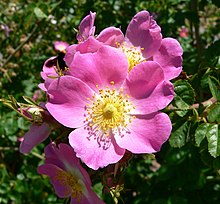
Flower
A flower, sometimes known as a bloom or blossom, is the reproductive structure found in flowering plants (plants of the division Magnoliophyta, also called angiosperms). The biological function of a flower is to effect reproduction, usually by providing a mechanism for the union of sperm with eggs. Flowers may facilitate outcrossing (fusion of sperm and eggs from different individuals in a population) or allow selfing (fusion of sperm and egg from the same flower). Some flowers produce diaspores without fertilization (parthenocarpy). Flowers contain sporangia and are the site where gametophytes develop. Flowers give rise to fruit and seeds. Many flowers have evolved to be attractive to animals, so as to cause them to be vectors for the transfer of pollen.In addition to facilitating the reproduction of flowering plants, flowers have long been admired and used by humans to beautify their environment, and also as objects of romance, ritual, religion, medicine and as a source of food.
from:
http://en.wikipedia.org/wiki/Flower
Types of Flower

Ang sampaguita ay isang shrub na tumutubo ng may taas na mula isa hanggang dalawang metro. Ang mga dahon ay makintab, hugis bilog o pahaba. Ang bulaklak naman nito ay kulay puti, mahalimuyak, at may hugis na parang-bituin. Ito ay maaaring paramihin sa pamamagitan ng stem-cutting at layering. Namumuhay ito sa matabang lupa at matatagpuan sa buong bansa.
from:
http://fil.wikipilipinas.org/index.php?title=Sampaguita_(bulaklak)

A rose is a woody perennial of the genus Rosa, within the family Rosaceae. There are over 100 species. They form a group of plants that can be erect shrubs, climbing or trailing with stems that are often armed with sharp prickles. Flowers vary in size and shape and are usually large and showy, in colours ranging from white through yellows and reds. Most species are native to Asia, with smaller numbers native to Europe, North America, and northwest Africa. Species, cultivars and hybrids are all widely grown for their beauty and often are fragrant. Rose plants range in size from compact, miniature roses, to climbers that can reach 7 meters in height. Different species hybridize easily, and this has been used in the development of the wide range of garden roses.[1]
The name rose comes from French, itself from Latin rosa, which was perhaps borrowed from Oscan, from Greek ρόδον rhódon (Aeolic βρόδον wródon), itself borrowed from Old Persian wrd- (wurdi), related to Avestan varəδa, Sogdian ward, Parthian wâr.[2][3]
from :
http://en.wikipedia.org/wiki/Rose

ng santan[1] o Ixora coccinea ay isang uri ng palumpong na may kulay puti, pula, at rosas na mga bulaklak. Kilala rin ito bilang heranyo ng gubat, ningas ng kagubatan, at liyab ng gubat. Nagbuhat ang pangalang pang-agham nito mula sa isang itinuturing na diyos sa Indiya. Isa itong pangkaraniwang halamang palumpong na likas at katutubo sa Asya. Bagaman may ilang 400 uri nitong nasa saring Ixora, kakarampot lamang ang pangkaraniwang itinatanim at inaalagaan at karaniwang ginagamit ang pangalang Ixora para sa I. coccinea, isang makapal at maraming sangang palaging-lunting palumpong, karaniwang 4 hanggang 6 talampakan (1.2-2 metro) ang taas, subalit may kakayahang umabot hanggang 12 talampakan (3.6 metro) ang taas. May bilugan itong hugis, na may bukang maaaring lumampas sa kaniyang kataasan. May mga 4 pulgada (10 sentimetro) ang haba ng mga dahon nitong makintab, tila katad, at may oblong na hugis, may buong gilid, at dinadala sa magkabilang pares o nakapalibot sa sa mga sanga ng halaman. Sa buong taon, nagkakaroon ito ng mga maliliit na malatubo at iskarlatang mga makapal at biluging kumpol ng mga bulalaklak (2-5 pulgada; 5-13 sentimetro). Maraming mga kultibar na nagkakaiba-iba sa sukat at kulay ng mga bulaklak (dilaw, rosas, at narangha). May ilang mga tanyag na mga bansot na kultibar na nananatili sa ilalim ng 3 pulgada (1 metro) ang taas. Isang kilalang bansot na santan ang Ixora Nora Grant, samantalang isang popular na haybrid ang Super Hari (Ingles: Super King) na may mas malaking kumpol ng mga bulaklak kung ihahambing sa ibang mga uri.
from:
http://tl.wikipedia.org/wiki/Santan

One of the more attractive species in the genus, Catasetum spitzii will produce an arched inflorescence with up to thirty good sized flowers on a healthy plant. From the lowlands of central Brazil, like most catasetums, it is deciduous and drops its leaves in winter during which time water and fertilizer should be withheld. One of the desireable traits of this species is the variability of flower color forms. There are green, yellow, yellow and red, near-white and in between color forms that can be found. A flat, waxy lip adds to its attractiveness. The plant pictured here was exhibited by Andrew Mack and awarded at the 2004 Fort Lauderdale orchid show.
from:
http://www.orchidworks.com/

One of the more attractive species in the genus, Catasetum spitzii will produce an arched inflorescence with up to thirty good sized flowers on a healthy plant. From the lowlands of central Brazil, like most catasetums, it is deciduous and drops its leaves in winter during which time water and fertilizer should be withheld. One of the desireable traits of this species is the variability of flower color forms. There are green, yellow, yellow and red, near-white and in between color forms that can be found. A flat, waxy lip adds to its attractiveness. The plant pictured here was exhibited by Andrew Mack and awarded at the 2004 Fort Lauderdale orchid show.
from:
http://www.orchidworks.com/